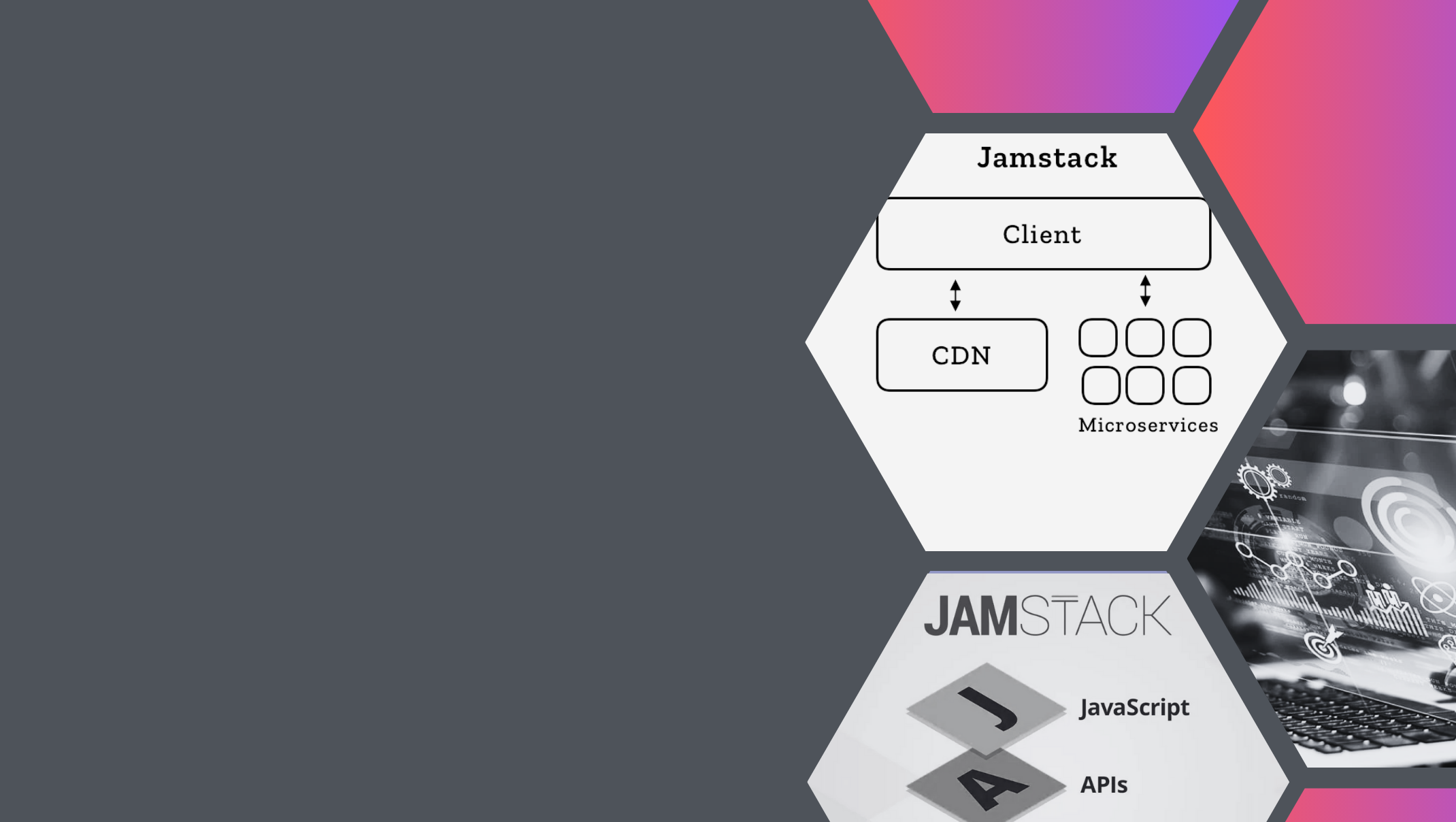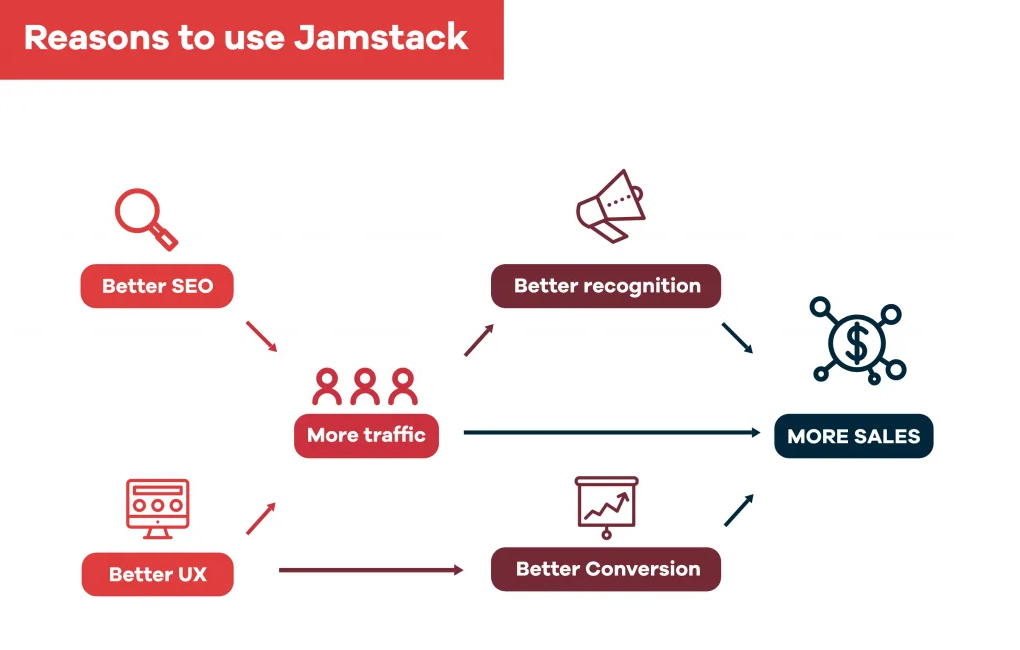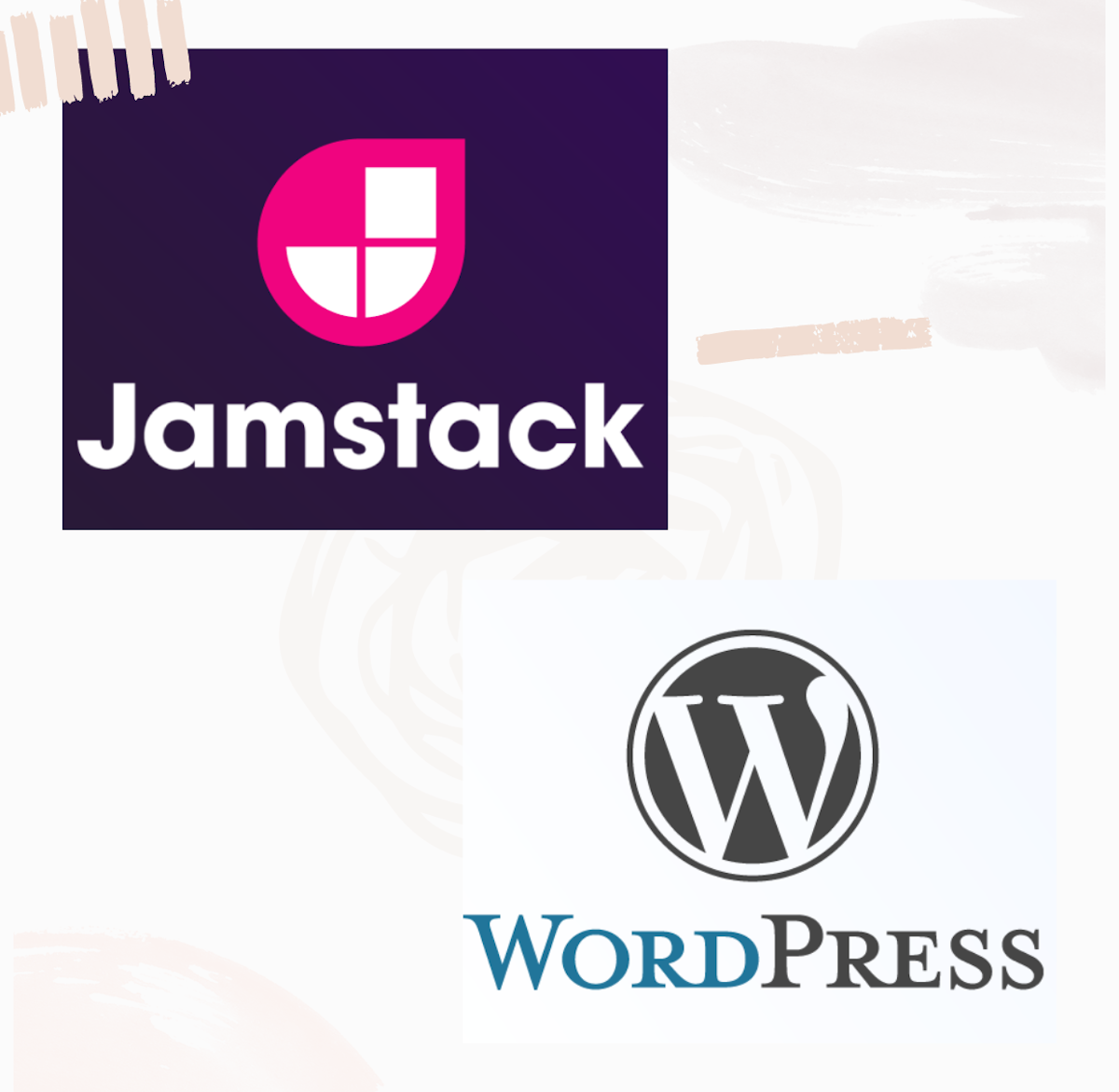
Jamstack CMS: Powering Modern Web Development
by Irina KedyarovaJuly 13th, 2023
Summary
What is a Jamstack?
The Advantages of Jamstack CMS
Does Jamstack have a backend?
Is Jamstack better than WordPress?
Is Jamstack good for eCommerce?
FAQs
Scroll to read all the article.
What is Jamstack CMS?
Jamstack CMS is a modern approach to content management systems that leverages the Jamstack architecture to deliver fast, secure, and scalable websites and applications. Jamstack, an acronym for JavaScript, APIs, and Markup, eliminates the need for server-side processing and offers a static-first approach to web development.
Is Jamstack a CMS?
Jamstack is not a CMS (Content Management System) itself. Jamstack is an architectural approach to web development that stands for JavaScript, APIs, and Markup. It emphasizes pre-rendered static files, decoupling the front-end and back-end, and leveraging APIs for dynamic functionality.
However, Jamstack can be used in conjunction with a CMS to build modern and performant websites and applications. The CMS in a Jamstack setup serves as the content management and editing interface, allowing content creators to easily manage and update website content. The CMS generates the necessary static files, which are then deployed to a content delivery network (CDN) or hosting provider, making them available to end-users.
By combining a CMS with the Jamstack architecture, developers can take advantage of the CMS's content management capabilities while enjoying the benefits of a fast, secure, and scalable website or application.
Is Jamstack full stack?
Jamstack, as an architectural approach to web development, focuses on the front-end and relies on pre-rendered static files and APIs for dynamic functionality. While it doesn't encompass the traditional notion of a full-stack development approach, it does have a defined scope within the web development stack.
In a Jamstack setup, the front-end layer is a crucial component where the static files are generated and served to the end-users. This layer typically consists of HTML, CSS, and JavaScript. However, the back-end layer, which handles server-side processing and database operations, is often offloaded to third-party services or APIs.
This means that while Jamstack doesn't cover the entire stack, it still requires integration with various services and APIs to handle dynamic functionality such as form submissions, authentication, and database operations. So, in a sense, Jamstack can be considered a subset of the full stack, with a focus on the front-end and leveraging APIs for the back-end functionality.
Is Jamstack open source?
Jamstack is not tied to any specific technology or framework and is an open architectural approach to web development. It promotes the use of open-source tools, frameworks, and services to build fast, secure, and scalable websites and applications.
There are numerous open-source tools and frameworks available that align with the Jamstack principles. For example, static site generators like Gatsby, Hugo, and Jekyll are widely used open-source solutions that facilitate the generation of static files. Additionally, many headless CMS platforms, such as Strapi and Ghost, offer open-source options for managing content in a Jamstack setup.
Moreover, the Jamstack community is highly collaborative and open, with developers sharing their knowledge, best practices, and open-source projects. This open nature of Jamstack allows developers to leverage and contribute to a rich ecosystem of open-source tools, making it a versatile and adaptable approach to web development.
The Advantages of Jamstack CMS
Jamstack CMS brings several advantages to developers and content creators:
Improved Performance:
By serving pre-built static files, Jamstack CMS eliminates the need for dynamic rendering, resulting in faster page load times and better user experiences.
Enhanced Security:
With reduced attack vectors and no server-side vulnerabilities, Jamstack CMS offers improved security for websites and applications.
Scalability:
Jamstack CMS can handle high traffic loads effortlessly due to the inherent scalability of static files.
Decoupled Architecture:
Separating the front-end from the back-end allows for more flexibility, enabling teams to work independently and choose the best technologies for each layer.
Version Control:
Jamstack CMS leverages Git for version control, providing a robust and reliable system for managing content changes.

Does Jamstack have a backend?
In the traditional sense, Jamstack does not have a backend in the same way as a traditional monolithic or server-side application. In Jamstack, the backend functionality is handled by third-party services or APIs.
In a Jamstack architecture, the focus is on decoupling the front-end and back-end. The front-end consists of pre-rendered static files (HTML, CSS, JavaScript) that are generated during the build process. These files are then served to the end-users directly from a content delivery network (CDN) or a hosting provider.
For dynamic functionality, such as form submissions, user authentication, and data retrieval, Jamstack relies on APIs and services. These APIs can be hosted on serverless functions, third-party services, or custom-built APIs. The front-end layer interacts with these APIs to handle the required functionality.
By leveraging APIs and services for the back-end functionality, Jamstack architectures offer scalability, security, and performance benefits. This separation of concerns allows developers to choose the best tools and services for each aspect of their application while enjoying the benefits of a fast and scalable front-end.
Is Jamstack better than WordPress?

Comparing Jamstack and WordPress is like comparing two different approaches to web development. Each has its own strengths and considerations, and the choice between them depends on specific project requirements and goals. Let's explore some key points to consider when evaluating Jamstack and WordPress:
Performance:
Jamstack excels in performance by serving pre-built static files directly to users, resulting in faster page load times. WordPress, on the other hand, may require server-side processing, which can impact performance, especially with heavy traffic or complex sites.
Scalability:
Jamstack's static file approach enables effortless scalability as static files can be cached and served globally through CDNs. WordPress can also handle high traffic, but it may require additional optimization and caching mechanisms.
Customization and Flexibility:
WordPress offers extensive customization options through themes, plugins, and a robust ecosystem. It provides a comprehensive content management interface and a wide range of functionality out of the box. Jamstack, while more focused on the front-end, offers flexibility by allowing developers to choose from various tools and services to build custom solutions.
Content Editing Experience:
WordPress is well-known for its user-friendly content editing interface, making it accessible to non-technical users. Jamstack CMS platforms are catching up in terms of user experience, but may require a steeper learning curve or technical expertise.
Security:
Both Jamstack and WordPress can be secure when implemented properly. Jamstack's static files and reduced attack surface contribute to its inherent security advantages. WordPress, being a popular CMS, requires careful maintenance, regular updates, and security plugins to mitigate vulnerabilities.
Community and Support:
WordPress has a vast community and a wide range of resources, including themes, plugins, and forums. Jamstack is a growing ecosystem with an active community, but it may not have the same level of support and resources as WordPress.
Ultimately, the choice between Jamstack and WordPress depends on the specific project requirements, the development team's expertise, and the desired balance between performance, flexibility, and ease of use. Both approaches have their merits and can be effective solutions in the right context.
Is Jamstack good for eCommerce?
Jamstack can be a suitable choice for building eCommerce websites. While Jamstack's architecture is typically associated with static websites, there are ways to incorporate dynamic functionality and meet the requirements of eCommerce.
Here are some reasons why Jamstack can be beneficial for eCommerce:
Performance:
Jamstack's static file approach, combined with CDN caching, can significantly improve website performance. Fast page load times are crucial for eCommerce, as they enhance the user experience and increase the likelihood of conversions.
Scalability:
Jamstack's ability to handle high traffic loads and its reliance on CDNs make it a scalable solution for eCommerce. Static files can be distributed globally, ensuring consistent performance across different regions.

Security:
Jamstack reduces the attack surface by minimizing server-side processing. With no server-side vulnerabilities, the risk of security breaches is reduced. Additionally, the use of APIs for dynamic functionality allows for controlled and secure interactions with external services.
Flexibility:
Jamstack allows developers to choose the best tools and services for specific eCommerce requirements. There are headless CMS options that can be integrated with Jamstack, providing a centralized content management system for managing products, inventory, and other eCommerce-related data.
Integrations:
Jamstack can easily integrate with various third-party services and APIs commonly used in eCommerce, such as payment gateways, inventory management systems, and shipping providers. This flexibility enables the customization and extension of eCommerce functionality.
Maintenance:
With Jamstack, there is no need to worry about complex server infrastructure or software updates. The static files are generated during the build process and can be deployed easily, reducing maintenance overhead.
While Jamstack offers advantages for eCommerce, it's important to consider the specific requirements of the project. Factors such as real-time updates, dynamic pricing, and inventory management need to be addressed using appropriate tools and services in the Jamstack ecosystem.
Best Frequently Asked Questions (FAQs)
Jamstack CMS offers a modern and efficient approach to web development, combining the advantages of a content management system with the performance benefits of the Jamstack architecture. By leveraging Jamstack CMS, developers can create fast, secure, and scalable websites and applications. With its growing popularity and numerous benefits, Jamstack CMS is set to revolutionize the way we build and deliver content on the web.
Comments
As someone new to Jamstack CMS, I found this article to be extremely helpful. The outline and headings provided a roadmap of what to expect, and the content was engaging and easy to understand. I appreciated the inclusion of real-world examples, which helped me see the practical applications of Jamstack CMS. Overall, a well-researched and well-written article.
Emily R.
Leave your comment
Your feedback is very important to us. Share your thoughts on what you read, or tell your own story.
Rating